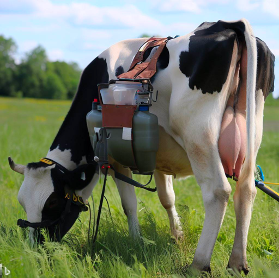

Nothing is safe–even the cows.
The environmentalist movement is taking aim at cattle farming due to the methane byproduct from cattle digesting grass. Chiefly using carbon taxes, it’s thought that taxation will increase the price of beef and dozens of cow byproducts and therefore decrease the amount of beef consumed by buyers–potentially bankrupting cattle farmers who can’t keep up with a changing landscape.
All is not lost, however. Future cattle farmers may turn to wild solutions to tame their leaky methane problem, including Bitcoin mining.
By viewing their cattle as mobile energy factories, farmers may be able to monetize cattle methane. Despite the popular ‘cow fart’ rhetoric, 95% of produced methane actually exits a cow via belching. If a farmer can prevent that methane from getting burped into the atmosphere, they may be able to avoid a future carbon tax.
Theoretically, cattle farmers can collect methane gas by connecting a tube to an escape valve along the cattle’s digestive tract, capturing the methane gas before it abruptly dissipates. While direct methane gas extraction would work best for stationary cattle, a sci-fi methane backpack can extract methane from outdoorsy cows, contain it and then release it into a nearby extractor. Think Cow-Matrix.

The cattle’s extracted methane gas can be collected and fed through a central turbine on site, generating electricity for bitcoin mining or selling it back onto the grid. The cattle farmers can reduce their emissions (potentially avoiding carbon taxes) while generating an additional revenue stream for their business.
Okay, so how much revenue are we talking?
A single cow emits between 154-264 pounds of methane each year. If a farmer could harness all of a cow’s produced methane, each cow could generate between 104-174 kWh per year. On a farm with 100 cows (assuming ~140 kWh per cow per year), a farmer could power up to 26 S9s (assuming S9 power consumption of 1,500 watts) on the harnessed methane at low operating costs.
The 80+ million cattle in the USA could theoretically power 20.8 million S9s. Mining farms are about to get a whole new meaning.
Now that a farmer is harnessing cow methane to generate power via a turbine, farmers can turn to a secondary energy source produced by their mobile energy factories–cow manure. In fact, many farms in North America already do so. A current bottleneck is that a farm typically needs 500 or more cows for the necessary biodigester to be feasible, and 500 cows per farm are much larger than most farms in the USA and Canada. Luckily, biodigester feasibility may lower to only 100 cows per farm, putting the technology in reach of many more farmers.
Cattle farms with 100 cows and a biodigester can annually save up to $11,600 in water heating, $33,000 in liquid fertilizer, and an additional $6,700 from animal bedding used from the biodigester’s bioproducts.
Cattle farmers of the future will have to innovate to navigate business-altering carbon taxes, although it appears there is a bright orange light at the end of the tunnel. If cattle farmers play their cards right, they may even come out ahead, producing more revenue and hashes than ever.
